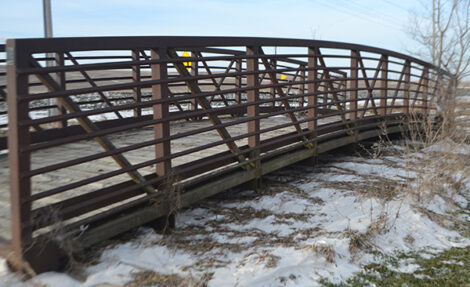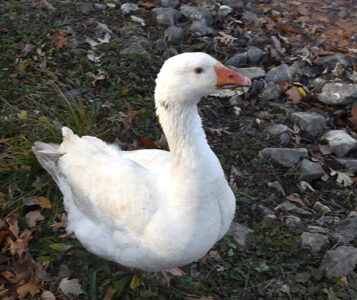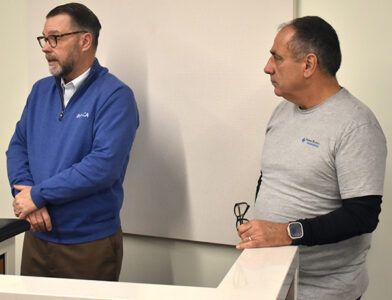State epidemiologist says source of Legionnaires’ outbreak is likely a cooling tower
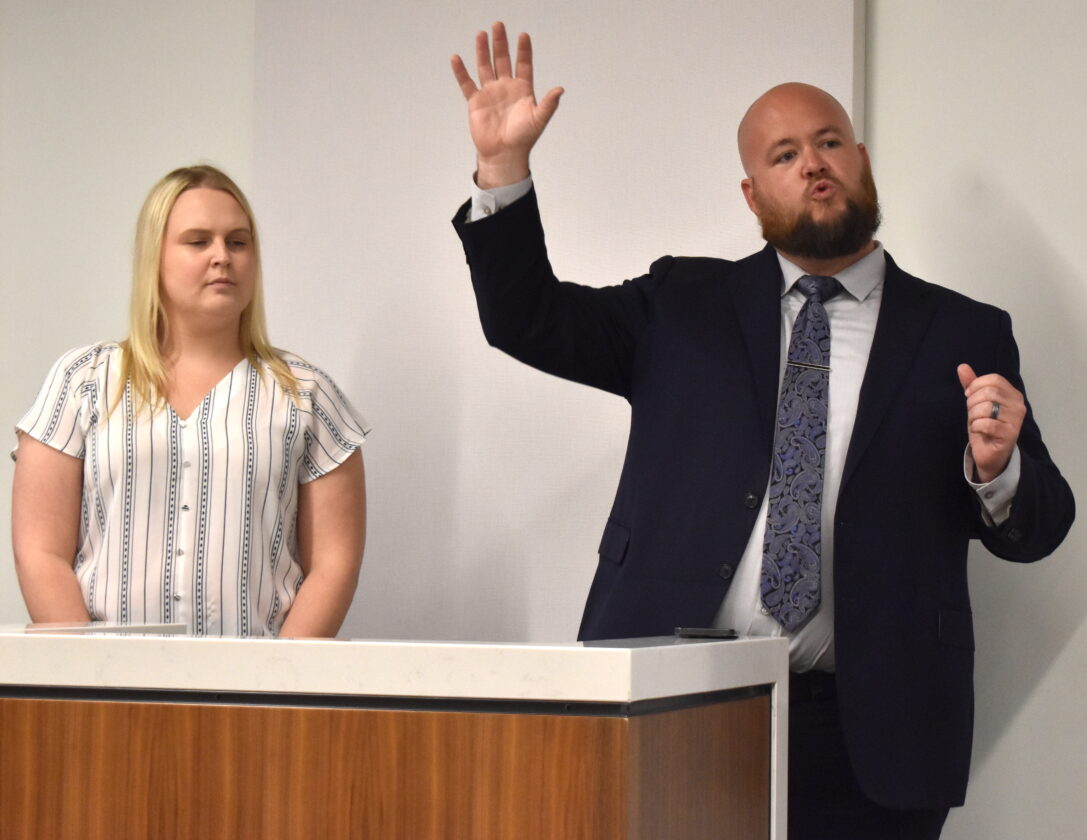
T-R PHOTOS BY ROBERT MAHARRY — State Epidemiologist and Iowa Health and Human Services (HHS) Deputy Medical Director Dr. Matthew Donahue, right, addresses the Marshall County Board of Supervisors about the Legionnaires’ disease outbreak while Marshall County Public Health Director Sydney Grewell, left, looks on during Wednesday morning’s meeting.
With the number of local Legionnaires’ disease cases up to 34 as of Tuesday afternoon, State Epidemiologist Dr. Matthew Donahue and County Public Health Director Sydney Grewell appeared before the Marshall County Board of Supervisors on Wednesday morning to provide an update on the situation as well as the potential source of the outbreak, which has been the source of much speculation over the last week.
After remarking on his own personal connection to Marshalltown through his grandparents and his plan to eat at Taylor’s Maid-Rite before departing, Donahue explained that he is an internal medicine physician who previously worked for the state of Nebraska before returning to his home state for a position with Iowa Health and Human Services (HHS) about a year ago. From there, he dove into Legionella, which is a bacteria normally found in freshwater environments like ponds, lakes, rivers, soil and gardens.
“Normally, when it’s in those places, it doesn’t cause a problem, but it really, really likes warm water. And Legionella can grow to higher levels when it finds warm water and a manmade system — something like a cooling tower, something like a water fountain or something like a hot tub. It’s one of the main reasons we disinfect hot tubs,” Donahue said.
Cooling towers, he noted, are mostly used in industrial settings for buildings that have a lot of warm water due to a large air conditioning system to remove heat from the system and pool water at the top of the building. Cooling towers bring hot water from the building up and use evaporation to get rid of it.
If Legionella makes its way into the system, it can multiply to high levels, and the evaporation can spread the bacteria into the air. Legionnaires’ disease can in turn cause a severe pneumonia in people, but it is treatable with antibiotics.
Because the bacteria is “everywhere,” most people who are exposed to it do not get sick at all, but those at the highest risk are those who are older, have smoked or have other medical conditions.
“One main message that I think we’ve talked about already is that anyone in the Marshalltown area who gets sick with a pneumonia like system with a respiratory illness should talk to their doctor about Legionella. It’s something we can test for really easy. It’s something that’s very treatable with antibiotics, and that’s been a core message we hope to get across,” Donahue said.
So far, the outbreak in Marshalltown has resulted in 34 cases of Legionnaires’ and one death, Father Bernard “Bernie” Grady. When the state receives a lab report, Donahue said his office traces the infected individual’s recent movements in an effort to figure out where they may have contracted the disease.
According to Donahue, HHS began to investigate as soon as a cluster of Legionella cases was identified in Marshalltown and released a Health Alert Network (HAN) advisory to area doctors on Wednesday, Sept. 3 before issuing a press release the following day, Sept. 4. He said state officials and Grewell have been in “constant contact” while receiving assistance from the federal Centers for Disease Control and Prevention (CDC).
“We’re trying to figure out exactly how people are getting sick with Legionella here, so we don’t have all the answers yet. But we are starting to hone in on a top hypothesis,” Donahue said. “It doesn’t look like this is coming from a hotel. It doesn’t look like this is coming from a water fountain. It doesn’t look like it’s coming from a hot tub. It’s most likely coming from a cooling tower. That’s what we’re honing in on. We don’t have a smoking gun. We might not find a smoking gun that tells us exactly how this happened, but because of how wide it appears to be spread, because of the calls we made to patients so far, that seems like the most likely answer.”
So far, officials have tested nine of the most likely cooling towers they believe could be responsible for the outbreak, though later, in response to a question from the T-R, Donahue sidestepped the question of where they are located and declined to provide a direct answer. He reiterated that the tests may not provide a firm answer, comparing them to a strep throat culture.
Even before results have come in, however, county and state officials are asking the businesses in question to disinfect their cooling towers, which will kill the Legionella and decrease the risk of it spreading further. As of Wednesday morning, four had already completed the disinfection process, and Donahue expressed confidence that the others would do the same.
“That’s forward progress even if we don’t have a smoking gun. We’re disinfecting the most likely sources while we’re waiting for those test results,” Donahue said.
As he summarized his presentation, Donahue urged anyone who believes they might be infected to consult with their doctor, and he then took questions from each of the three supervisors. Chairwoman Carol Hibbs sought clarity on the timeline from when the outbreak was discovered up to the present, and Donahue said the first cases were reported on Sunday, Aug. 24 before more cases “trickled in” the following week.
“Throughout that week, we realized we’re seeing more cases reported than what’s typical. We prioritized investigations and calling each one of those patients to try to figure out if it was something happening in Marshalltown or not,” he said. “As we were looking, Sydney was in contact with local (doctors) to say ‘Hey, we’re picking up some Legionella cases. Make sure you’re testing for it.'”
By the first week of September, he said they had enough cases and investigations completed to issue the HAN advisory and a press release. Grewell, speaking for the first time, said a few cases of Legionella are not particularly uncommon.
“We don’t notify the public every time somebody tests positive for something. There’s things that are done on the back end, and it’s usually me calling the patients,” she said.
Donahue added that he felt the timeline worked “really well,” and information was shared in a timely manner once it was determined that the source of the outbreak came from within Marshalltown and not travelers going elsewhere.
“I think this was the system working exactly as it should, and I don’t know if it would’ve been possible to do anything earlier,” he said.
Hibbs then asked about transmission methods of the bacteria, and Donahue said it is spread through water droplets in the air from a system with warm water being sprayed into the air. There is no person-to-person transmission of the bacteria and the disease. Grewell added that it doesn’t come from drinking water, and Marshalltown Water Works General Manager Zach Maxfield clarified that the city’s drinking water supply was not tied to the outbreak in any way at Monday night’s council meeting.
Supervisor Kevin Goodman wondered about the risk of contracting the disease through Continuous Positive Airway Pressure (CPAP) machines, and Donahue said they would need to be appropriately disinfected per the instructions.
“Any device that heats water and sprays or humidifies it could be a risk for Legionella, and that’s why it’s important to disinfect them,” Donahue said.
Grewell noted that questions about humidifiers and CPAPs are part of the investigations they conduct. Supervisor Jarret Heil asked Donahue about whether the atmosphere could be tested, and he replied that testing the air doesn’t typically produce results — the best they can do is testing the water from the cooling towers. He also wondered about the timeline on the new cases coming in and whether it could be determined when the individual was exposed.
According to Donahue, infected individuals can be exposed anywhere between two and 14 days before testing positive. Heil then asked Donahue if he could reassure the public that it’s safe to visit Marshalltown.
He responded that most people are exposed to Legionella every day and don’t get sick, and he was excited to be in the community for several reasons.
“I wouldn’t cancel a plan to Marshalltown. I wouldn’t not go out to eat at a restaurant or visit a local shop because of the outbreak that’s happening now from Legionella, especially with as far as we’ve gotten at this point,” Donahue said.
Finally, Heil sought information on how cooling towers are regulated for future reference to avoid similar outbreaks going forward. Grewell said she has been conducting the tests on the cooling towers with assistance from the state and has recommended remediation by cleaning the towers and reviewing the systems they have in place to deal with them. Some of the businesses, Grewell said, have committed to stepping up their cooling tower maintenance.
“Because of this, I think we’re moving forward to prevent this in the future and not hope it happens again because it’s very easily done because of the stagnant water that’s hanging out in those cooling towers,” she said. “In Iowa, we tend to go hot and cold from one week to another, and that produces it sometimes as well.”
Donahue added that anyone with a cooling tower should have a water management plan that ensures regular disinfection. The results of the tests, which are being conducted at the State Hygienic Lab in Iowa City, could come back as early as this week, but they also may not come back at all if the bacteria isn’t growing in a sample.
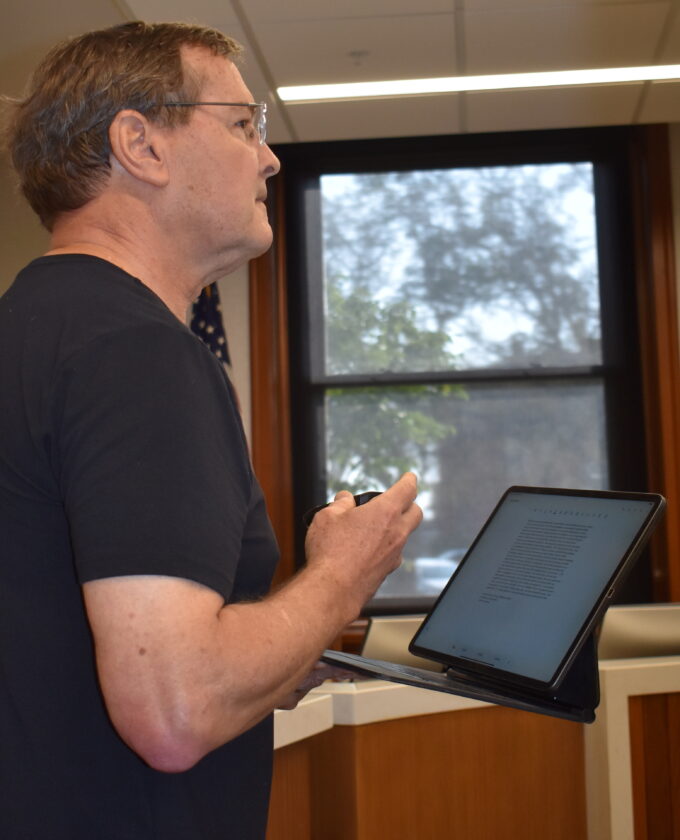
Marshalltown Mayor Joel Greer addressed Donahue and Grewell with questions about the Legionnaires’ disease outbreak during Wednesday morning’s Marshall County Board of Supervisors meeting.
Marshalltown Mayor Joel Greer came forward and reported that he’s being “inundated” by messages and interview requests regarding the outbreak, asking Donahue about testing methods — to which he replied that for people, Legionella is primarily detected in urine and sputum. For environmental tests like a cooling tower, a culture is the only option, and it takes “quite some time.”
Greer also asked how many tests were left to complete on cooling towers and if volunteers could be enlisted to help Grewell conduct them. She said she had one test left on Wednesday afternoon on top of the nine already finished, and they will continue to search for additional potential sources of the bacteria.
“Thankfully, the testing itself is not difficult. I have found myself on top of some roofs recently, but the testing itself is not difficult. It’s, of course, getting in contact with the right people to get to those cooling towers because a lot of them are on top of high places or in secure areas, as they should be,” Grewell said. “It helps to be a Marshalltown local and grow up here to have those connections with people.”
As the floor was opened up for public questions, the T-R asked Donahue and Grewell for locations of the cooling towers, to which he responded that they’re on the tops and sides of buildings.
“That’s not the question I’m asking,” the author said.
“We don’t have a specific location to give you. What we’re doing is ensuring each one that is possibly the source is disinfected. There’s no smoking gun,” Donahue said.
Hibbs did clarify that they’re still working within the “north central” area of Marshalltown. Mark Wyant then asked if the outbreak could possibly be tied to the food supply with the local JBS plant producing so much meat on a daily basis.
“Legionella is not transmitted through eating or drinking,” Donahue said.
With the discussion wrapping up, Hibbs thanked Grewell for her “heroic efforts” climbing on buildings to perform testing and Donahue for traveling to Marshalltown to provide an update. In response to an inquiry from the T-R, Marshalltown Housing and Community Development Director Deb Millizer said the city doesn’t keep a list of buildings with cooling towers, and to determine which businesses have them, they would have to pull the individual plans for each.

